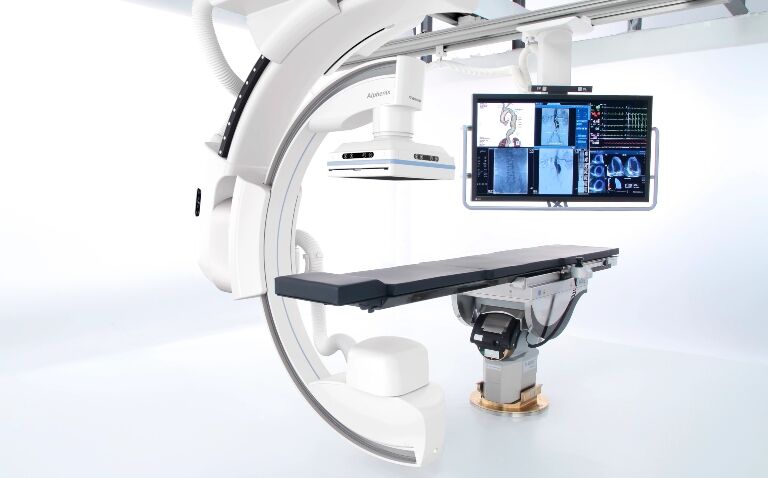Facing increasing pressure to free up hospital beds, many clinicians are embracing innovation to optimise the treatment of common conditions such as benign prostatic hyperplasia. Here, Dr Pavan Najran, consultant interventional radiologist at The Christie NHS Foundation Trust, discusses how ceiling-mounted interventional radiology is revolutionising prostate artery embolisation for clinicians, patients and the wider healthcare system.

Benign prostatic hyperplasia (BPH) is one of the most common urological conditions among males, with around 40% of men over 60 having lower urinary tract symptoms due to an enlarged prostate, according to The Urology Foundation. Although not life-threatening, the condition sees the prostate become larger than normal, which can cause lower urinary tract symptoms and complications that can affect quality of life.
For many, prostate screening is a critical part of early diagnosis. In fact, prostate artery embolisation (PAE), a non-surgical procedure using interventional imaging systems to shrink an enlarged prostate or BPH, is gaining traction across the industry.
Hospitals such as The Christie NHS Foundation Trust in England are now opting for minimally invasive PAE using interventional radiology (IR) to treat patients, which has helped improve and speed up patient recovery and has subsequently helped free up hospital beds.
Usually, BPH patients would be referred by a urologist for transurethral resection of the prostate (TURP), which would entail a more invasive surgical procedure. This surgical procedure would then result in the patient needing a general or spinal anaesthesia and at least a two- to three-day recovery stay in the hospital.
Move the system, not the patient
Studies have proven PAE has similar outcomes to TURP. Patients now have the option of a minimally invasive alternative which would favour those who are not suitable for or prefer not to have invasive surgical treatment.
BPH is a common problem for men who suffer from lower urinary tract symptoms which can be debilitating. Men now actively seek alternative treatment options which includes PAE to help resolve such severe symptoms.
The shift to same-day treatments was accelerated during the Covid years there was a need to limit the use of inpatient beds. PAE was protocolised as a day case with discharge of patients the same day.
This was made possible by having a ceiling-mounted interventional imaging system giving us the ergonomic flexibility to switch to transradial access (TRA) via the patient’s wrist on the left side rather than transfemoral access via the groin on the right. TRA is known to have fewer complications at the access site and is more comfortable for the patient, so it aided the confidence in decision making to speed up our discharge rates.
It sounds like a small point when focusing on big clinical issues, image quality and low dose, but the ergonomics of an IR system are essential. You need to be able to walk 360 degrees around your patient or swing the C-arm around. Floor mounted or fixed robotic systems create physical barriers to getting to the top end of the patient to place jugular lines or orientate larger teams in a small space.
High image quality and low dose management
PAE is typically a two-hour procedure involving an interventionist and radiographer technician team. Image quality for navigation accuracy and decision certainty is vital, as is a dose management system to safeguard the patient throughout the procedure and control cumulative dose management for clinical operators.
Cone beam CT is essential for PAE as we need to confirm vessel certainty in supplying the prostate. Traditional angiography in this region isn’t conclusive as there are small vessels that you may not identify on an anterior posterior image. Therefore, cone beam CT on the IR system can identify very small vessel branches that supply areas at the base of the penis, bladder or rectum. This insight helps with decision-making to either embolise or identify an alternative embolisation point.
Dose reduction is also essential to manage the cumulative dose for the operators working in the room. We need to conserve the dose as much as possible and it was one of the factors in our system selection.
Putting patient needs first in IR
The Christie NHS Foundation Trust is the largest single site cancer centre in Europe, treating more than 60,000 patients a year. Based in Manchester, it serves a population of 3.2 million people across Greater Manchester and Cheshire with a quarter more patients also referred from across the UK.
As a cancer centre we try and promote a relaxed atmosphere with a holistic philosophy to reduce the anxiety patients may potentially feel. Whilst the PAE procedures are for benign conditions such as BPH, it is still our aim to provide the highest level of choice and a calm environment.
Medical imaging solutions company Canon Medical worked closely with us at the start of our PAE journey, it helped us gain timing accuracy for contrast delivery with the cone beam CT. This resulted in defining a PAE protocol.
The true value of interventional radiology
Over the last decade, we have witnessed the expansion of patient services due to technological advancements. With the implementation of IR systems, new services have been created to treat patients. An example of this includes Chemosaturation procedure which is a complex treatment involving cardiac bypass and administering high-dose chemotherapy directly into the hepatic artery with systemic circulation isolation.
Delivering innovative procedures for patients is a key goal for the interventional department at The Christie Hospital. Ergonomic, space-saving, ceiling-mounted interventional imaging equipment helps us deliver personnel-heavy procedures, allowing us to have up to 14 essential people in the IR suite including interventionists, cardiac perfusionists, anaesthetists, radiographers and nurses.
Interventional imaging is experiencing exciting developments. We are now seeing a variety of techniques that emphasise minimal invasion as a result of evolving advancements in image quality dosage and system ergonomics. With new procedures and innovation being introduced into hospitals, this will raise the standard of care and improve patient experience while lowering overall treatment costs.










